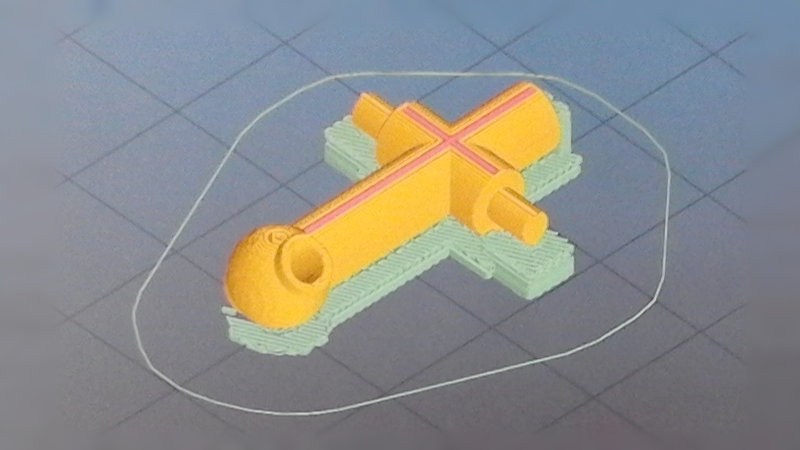Today, when we say “Jesus nut”, we’re not referring to the people who spend their days proselytizing down at the mall. The term, likely spawned in the Vietnam war, refers to the main nut holding the rotors on to the mast of a helicopter which is in the shape of the Christian cross. If the “Jesus nut” was to fail, the rotors would detach from the craft, and there would be little for crews to do except to pray.
[Marius] was presented with a failed Jesus nut, though thankfully from an R/C helicopter, meaning there was no loss of life. A friend needed the part replaced for their FQ777 copter, so it was time to bust out the 3D printer and get to work.
The first step was to reconstruct the broken piece so it could be measured and then modeled in CAD software with the help of calipers to determine the original dimensions. What followed will be familiar to many 3D printing enthusiasts — a case of educated trial and error, experimenting with different filaments and print settings until a usable part was produced. [Marius] notes on the part’s Thingiverse page that they achieved the best print with an 0.2mm layer height, and printing two parts at once to allow the layers more time to cool during each pass. It was then a simple matter of tidying up the part with sandpaper and a drill bit before installing it on the vehicle.
[Marius] reports that the part was successful, being both strong enough to withstand the forces involved as well as having a fit that was just right to suit the rotor pin which needs to be able to turn freely within the Jesus nut. While they’re not always the right tool for the job, 3D printed replacement parts can sometimes surprise you. These prints that are used in repair work often don’t attract the same interest as printing cosplay armor, kinetic art, and low-poly Pokemon. But they quickly prove how transformative having a 3D printer, and the skills to use it, are. That’s why we’re running the Repairs You Can Print contest… take a few minutes to show off the really useful repairs you’ve pulled off with your 3D printer!
















The term “Jesus nut”, and the similar “Jesus pins” that hold a hot air balloon basket to the balloon envelope also stems from the pilots using the phrase that the nut/pin/whatever and Jesus are the only things holding you up (or keeping you alive/ safe).
I’ve heard is as, “if it fails only Jesus can save you”
“If the Jesus nut comes off in flight, the next person you meet is Jesus.” is how I heard it.
Is this related in any way to the Jesus clip? That dastardly little lock ring which never fails to shoot itself across the room and roll under the toolbox, leaving you too curse the creator and order an assorted set on eBay, vowing never again.
Similar to the Jesus Springs in drum brakes. I have taken to putting a string through them before I attempt re-installation. When it does slip out of the pliers at mach 2 it never makes it more than a meter.
Well the Vietnam War was a very colorful time for the English language.
I’ve also hear Jesus Pin used for the clevis pins holding folding wings onto the fuselage of a light aircraft.
It’s been broadened to any single point of failure that causes catastrophic consequences.
Plenty of flaky jesuses around these days then.
The Jesus nut on a heli is not shaped as a cross!! For Gods sake it is a nut.
http://3.bp.blogspot.com/-pDZXa3JzxOo/UL_BCAI3_eI/AAAAAAAANYE/YbDltY2s9Wg/s1600/jesus_nut_helicopter.gif
I agree, it’s just a very large nut on top of the rotor assembly. The part this author printed has some other function. Also, the helicopter Jesus Nut term was started during the Korean war, not the Nam war!
The part in the article is just one of the control rods. Though I think on RC heli’s it does a little bit of both duties.
As a Vietnam helicopter pilot, I can tell you exactly where that term came from. The Jesus nut does indeed connect the rotor head to the transmission drive shaft. If you lose the Jesus nut, the only thing the pilot can say is “Oh Jesus”!
Frank G 195th ASSAULT HELICOPTER COMPANY and F/8th Cav. 1970-1971 the Republic of Vietnam.
https://en.wikipedia.org/wiki/Jesus_nut
I’ve never, ever actually heard of or seen any kind of Jesus nut that literally looks like a Christian cross before.
Somebody has obviously taken some artistic license here.
I think they are just wrong…
History note, his name wasn’t Jesus it was Joshua (Anglicized) and in actual Hebrew, it was something like Yeshua. A multi-layered transliteration between languages gets us from Yeshua to Iesus (starting with a capital “i”). And in about 1500s a brand new letter came along called “Jay” “j”, and this replaced men’s names starting with a “y/i”, so Yeremiah became Jeremiah, and Iesus became Jesus. Fun little factoid.
This, to me, falls in the “Parts you should just buy” category. You’ll be cheaper off than experimenting, and it’s most likely better for the environment too, even with the shipping. I doubt it would have been much slower too.